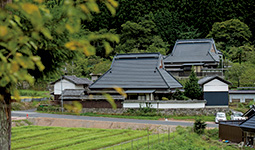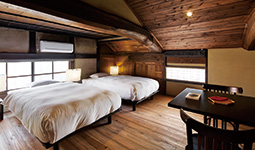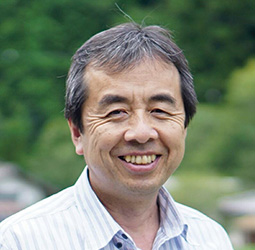Home > Highlighting JAPAN > Highlighting Japan May 2019 > Regional Revitalization
Highlighting JAPAN


How a Hotel Revived a Castle Town
Tamba-Sasayama City, Hyogo Prefecture, is home to a project that aims to revitalize the local area by restoring old Japanese-style houses.
Tamba–Sasayama, Hyogo Prefecture, a city surrounded by mountains with a population of 42,000, is a castle town centered on Sasayama Castle, which was built in the early years of the Edo period (1603–1867). Tamba-Sasayama is located about one hour away from Osaka and Kyoto by car, and still retains a large number of streets and buildings influenced by Kyoto culture over 400 years as well as buildings that inherit that tradition. The townscape around Sasayama Castle is of particular historical value and was designated as one of the National Important Preservation Districts for Groups of Traditional Buildings in 2004.
Besides the preservation district, the Maruyama area, located a 10-minute car ride away from the center, has traditional houses standing amid abundant mountain nature. However, the depopulation of the area led to traditional houses becoming vacant as residents left the land, leaving the abandoned houses to potentially fall into ruin.
One person who reacted to this was Yukio Kinno, representative director at NOTE Inc. Kinno founded NOTE in 2009 and started working to restore traditional houses in collaboration with local residents and NPOs, seeking support from banks and the authorities. By that time, seven out of twelve houses in the Maruyama area were already empty and the population had shrunk to twenty persons, meaning that the area was on the verge of disappearing.
NOTE held workshops with the local residents, continuously discussing a vision for the area’s future. Three 150-year-old unoccupied houses in the village were remodeled to create a single lodging house for rent, and an annex and storehouse were turned into a restaurant. In October that year, Village Maruyama opened. Residents are responsible for providing services such as reception, cleaning and breakfast at the lodging houses in Village Maruyama. Breakfast is homemade black bean miso soup and Maruyama rice, prepared with plenty of locally grown ingredients. Visitors can enjoy dinner at the restaurants in the village. One offers game dishes such as wild boar and deer, French cuisine using Tajima beef from Hyogo Prefecture and fish from Awaji Island. The other, which has been awarded one Michelin star, specializes in soba buckwheat noodles.
Village Maruyama is popular as a place where you can experience Japanese traditional living in a beautiful landscape. Today, it is visited by guests from home and abroad.
“The response was more enthusiastic than we expected and today, nine years since it opened, the village is a vibrant place. Over the next ten years, we plan to restore the remaining vacant houses, with a view to attracting inbound tourists,” says Kinno.
Next, NOTE worked on the restoration of traditional houses in the center of Tamba-Sasayama. In 2015, NOTE remodeled four traditional houses and started the first hotel business in the country in response to the 2014 designation of the entire area of Hyogo, Osaka and Kyoto as a Kansai National Strategic Special Zone and the approval of the Special Exemption to the Hotel Business Act for Historic Buildings. The key feature of the business is that one of the traditional houses dotted around Sasayama Castle was turned into the hotel’s reception, its five guest rooms and a restaurant, with the three other houses turned into a total of six rooms. After checking in at the front desk, guests enjoy the beautiful castle town as they make their way to their rooms.
The concept for the hotel is to make the entire castle town of Tamba-Sasayama into “a single hotel.” Aspects of many of Japan’s ancient traditions can be found in Tamba-Sasayama, such as a castle, a Shinto shrine with a noh stage, and festivals. Locating the front desk and restaurant away from the accommodation means that guests have to leave their room and walk around the castle town, being touched by the hearts of residents who cherish Tamba-Sasayama’s nature, history and culture.
Currently, NOTE Inc. is restoring around fifty unoccupied traditional houses, including ten accommodation facilities in Tamba-Sasayama, to create facilities such as restaurants, cafés, workshops and galleries. A sake brewery in the old capital of Nara is also being remodeled into a hotel. Such activities, which started in a small village, attracted tourists, encouraged people to move in from urban areas, and contributed to the creation of employment opportunities. They have had ripple effects too, such as the passing on of traditional architectural techniques, and the ripples continue to spread.
© 2009 Cabinet Office, Government of Japan









